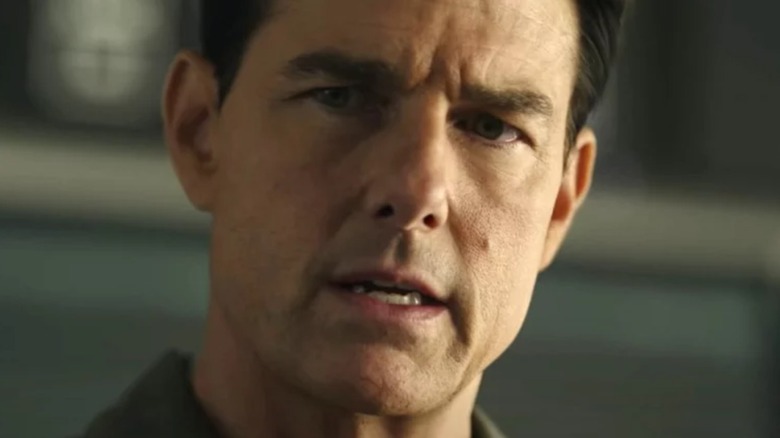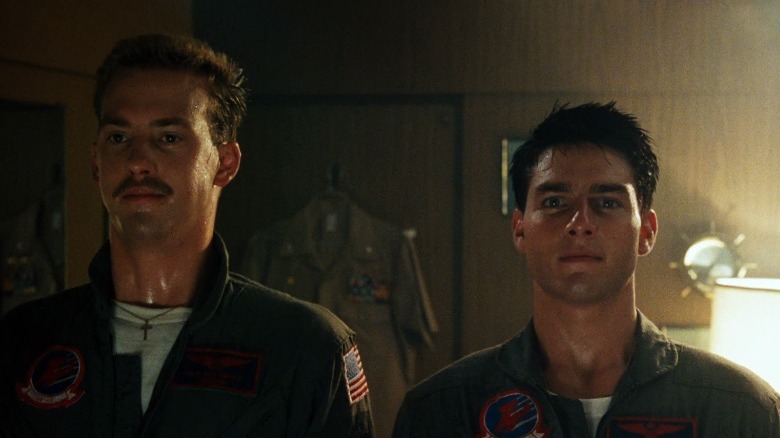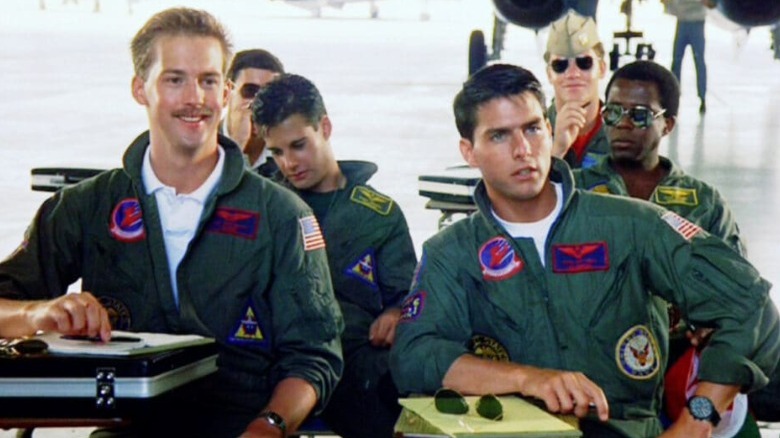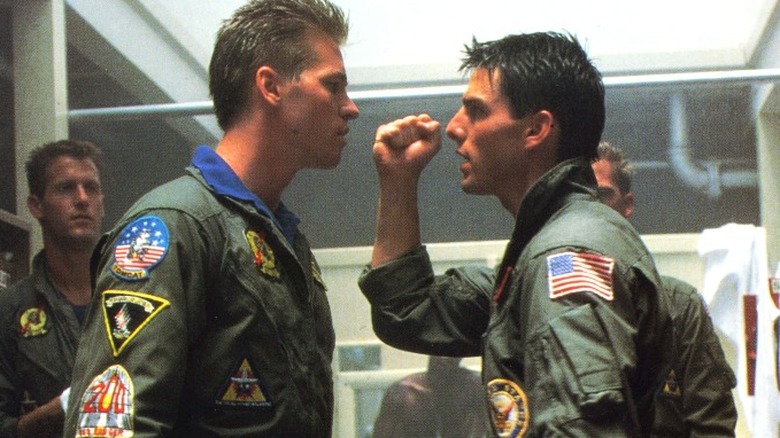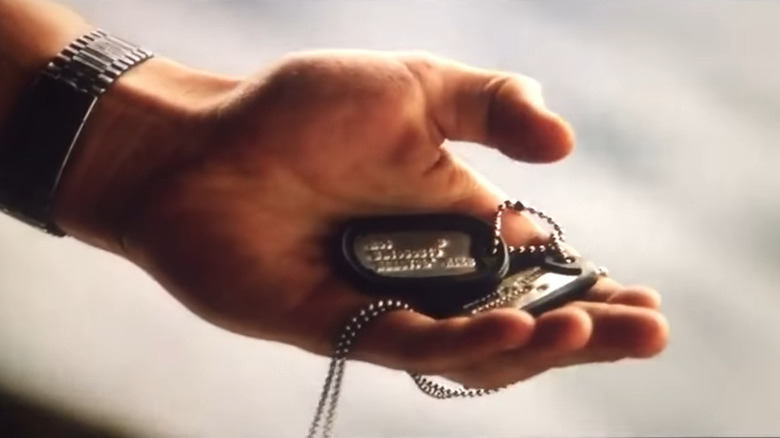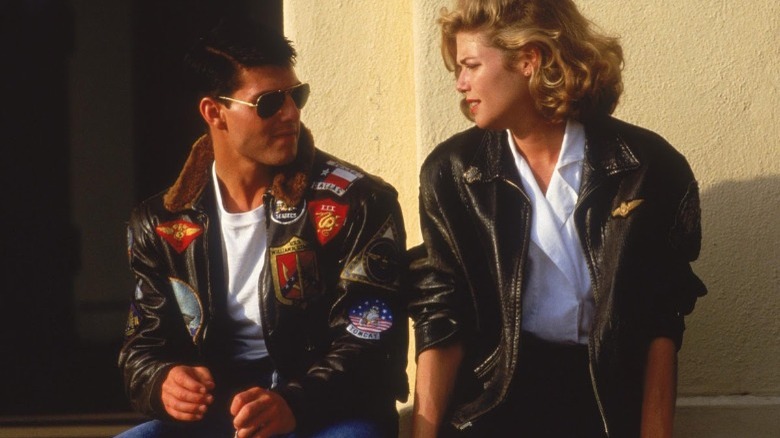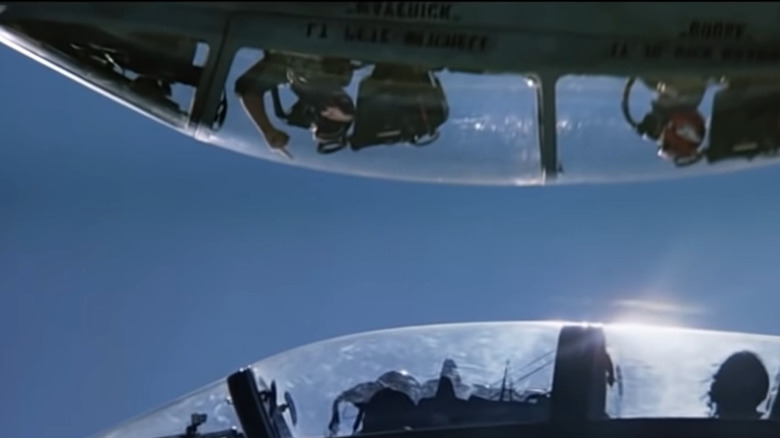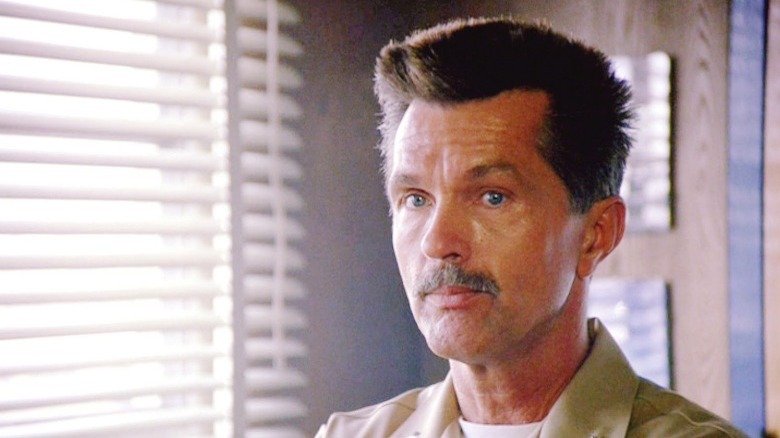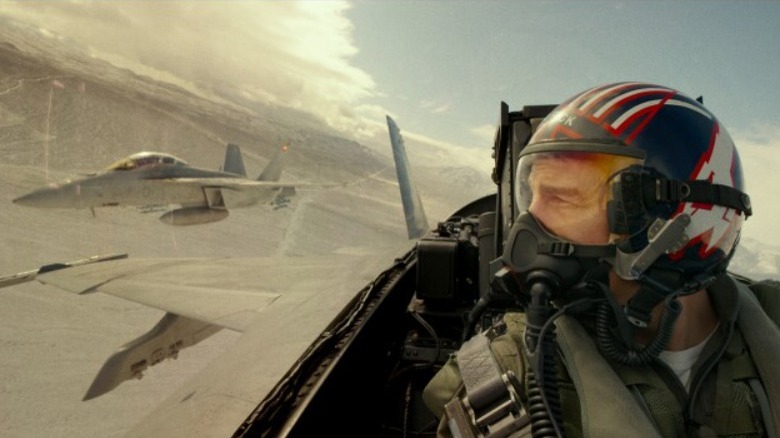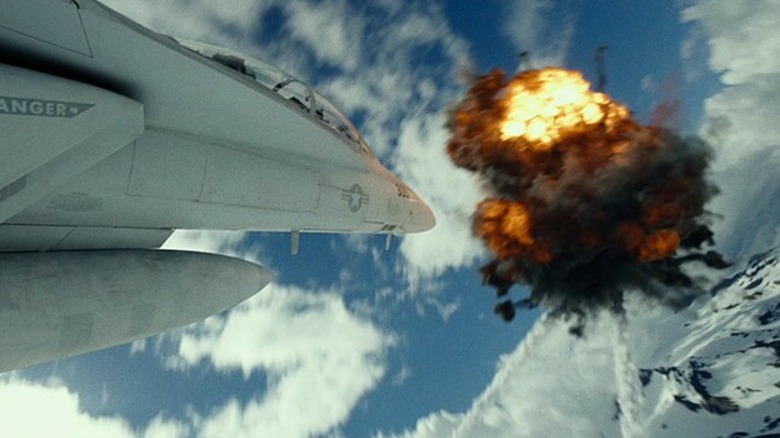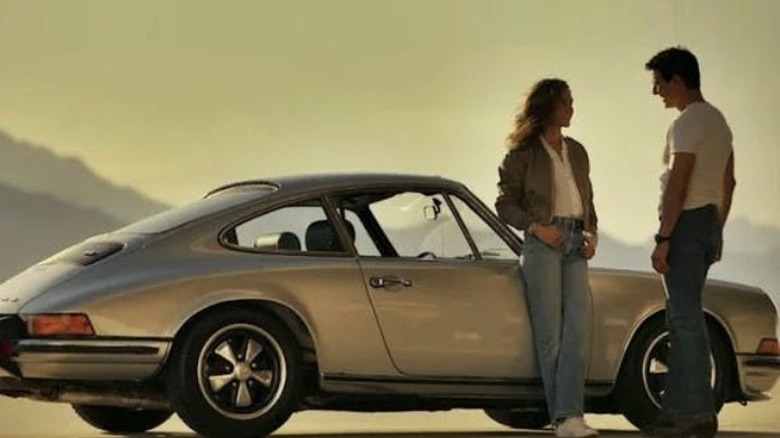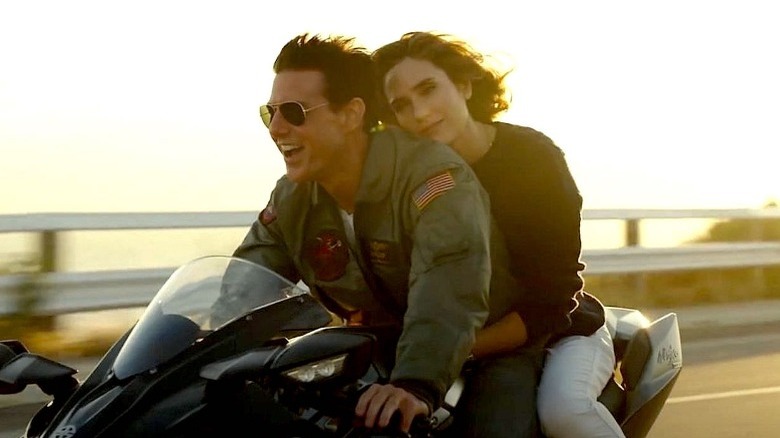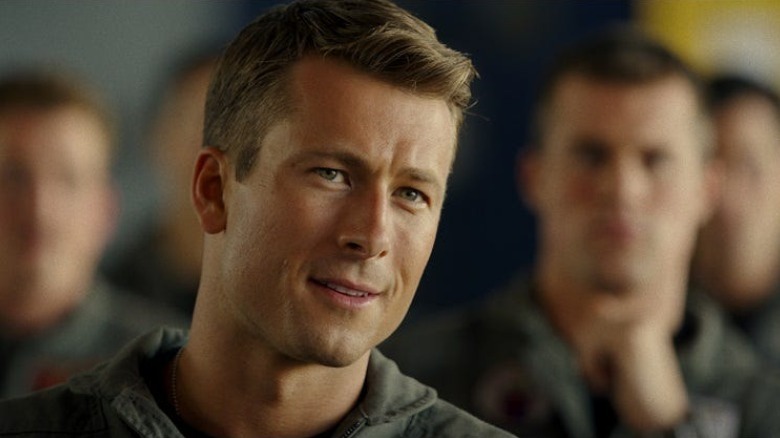Things In The Top Gun Movies That Make No Sense
"Top Gun" and its long-gestating sequel, "Top Gun: Maverick," aren't movies that set out to be realistic. They're more about mood: sunsets, killer needle drops, shirtless sports, and romance, with some aerial dogfighting for good measure. But for a pair of movies that are more about vibes than story, they can send the mind of even the most casually pedantic or detail-oriented viewer off on tangents and dead ends. To enjoy the "Top Gun" universe, you have to reach a sort of zen, calm-San-Diego-beach state of mind that doesn't involve asking too many questions, so as not to be left counting a small pile of answers.
As far as "Top Gun" and "Maverick" are concerned, the only way forward is the next scene — the next training exercise, the next dogfight, the next wistful, longing stare between ageless star Tom Cruise and his paramour of the decade. Both movies are in a world like this one, but couldn't reasonably happen in any version of reality in the geopolitical sense. The military they depict has an endless budget for planes but very few actual naval pilots somehow. Even the first movie was nostalgic for a bygone era: there's been virtually no dogfighting for several decades, and it hasn't been a major factor in armed conflict since World War II. Nonetheless, both movies work in spite of themselves, crowd-pleasing monuments to the value of entertainment over logical consistency. These are the things in the "Top Gun" movies that make no sense.
A military with no consequences
The most confusing aspect in both "Top Gun" movies is the relationship between order and chaos: how does our hero Pete "Maverick" Mitchell keep getting away with being such a, well, maverick within the confines of the Navy? The military is famously an institution exclusively based on following orders, emphasizing the life or death importance of the chain of command. Maverick routinely violates orders by going rogue: in each film he violates the law by flying under the "hard deck," the minimum altitude for training exercises for the protection of civilian life below. His recklessness gets his best friend Nick "Goose" Bradshaw killed, although he's cleared of wrongdoing.
More than three decades later, in "Top Gun: Maverick," he's no better: he wrecks an experimental supersonic jet and defies the commanders at TOPGUN with uncleared teaching methods. It's implied that his friend Tom "Iceman" Kazansky has been intervening on his behalf, but it beggars belief that this attitude would last more than a week in the actual Navy. So in the military of the movies' world, are orders a good thing or a bad thing? In "Top Gun" Maverick ultimately is rewarded for his talent in spite of his recklessness. In "Top Gun: Maverick," he's the one giving orders and the movie seems to agree that the younger pilots should follow them ... except when Goose's son Bradley "Rooster" Bradshaw (Miles Teller) defies them to save his life. It adds up to a strange sort of controlled chaos that doesn't reward critical thought.
Are the pilots seasoned or not?
Integral to the ethos of the "Top Gun" movies and the TOPGUN school is the idea that these pilot trainees are the best of the best. It's where the top 1% of new pilots go to study the most advanced flying maneuvers. But at the end of "Top Gun," a few of our brand-new class of graduates are called away urgently for a "crisis situation," while in "Top Gun: Maverick," the entire movie is based around teaching recent TOPGUN grads to fly a dangerous, urgent assignment to destroy a nuclear facility.
In both situations it's impossible not to wonder: even though these pilots are said to be the best, are there no more flyers more readily available? In two wildly different situations, with potentially wide-reaching global consequences, these pilots are called upon for absurdly sensitive and difficult assignments literally as they finish their advanced level of training. The elder Maverick ends up leading the mission himself in "Top Gun: Maverick," of course, but are there no other veterans out there with any chops at all? In the first "Top Gun," the cadets don't even have time to enjoy their graduation banquet: the plot intervenes to place them in a deadly situation that just doesn't seem like an actual entry-level assignment, even for the "best of the best."
Iceman is pretty reasonable
The most cognitively dissonant part of the first "Top Gun" is the relationship between our protagonist Maverick and his arch-rival, Iceman. If you just read the dialogue in their scenes, you might assume Iceman is actually the lead role, because every single thing he sneers at his reckless nemesis is actually just a very sensible thing to point out. Iceman is described as a talented and polished pilot, and he points out multiple times that Maverick acts irresponsibly by defying protocol and taking needless risks. The way the scenes are acted, and the tension that Val Kilmer and Tom Cruise capably bring to their roles, make you more likely to root for Maverick just out of movie-watching habit. Why is this blond jerk being so snide to our hero?
The thing is, Iceman is right: Maverick is talented but pure chaos, and even his superiors admit they have grave doubts about how his attitude will translate to combat. Maverick even indirectly gets Goose killed, and Iceman takes the high road and offers his sympathy instead of saying "I told you so." At the end of "Top Gun," Maverick saves Iceman's life in combat and they become lifelong friends, so all's well that ends well. But no one brings up that Maverick learned nothing: he ignored Iceman's level-headed and reasonable advice, and it all just kind of worked out for the best in spite of him.
Why does Maverick get Goose's dog tags?
Any moviegoer that's seen a war movie is familiar with the iconography of military dog tags. In countless scenes, they're recovered from the fallen as a symbolic gesture of carrying the memory of their service, and in due course passed on to the soldier's next-of-kin. Why then, in "Top Gun," does Maverick keep Goose's dog tags instead of giving them to his widow?
At first, distraught as he is with grief, it's understandable that he would hold onto them as he pondered whether to continue his career as a pilot. But ultimately, after the big climatic dogfight, Maverick cathartically throws them into the ocean, ensuring Goose's family will never get them. It could be argued that this is in keeping with Maverick's rather self-centered nature, but "Top Gun" lets us know with the score and general tone of the scene that it considers this a meaningful, thoughtful moment.
What does Charlie see in Maverick?
Maverick's appeal in both "Top Gun" movies is a self-fulfilling paradox. He's the main character — surely that means he's brave and not reckless? Also, beautiful women are drawn to him, so presumably he must be charming. But that doesn't hold up when you watch his actual interactions with Charlie Blackwood (Kelly McGillis) in "Top Gun." First, after a mildly amusing but also embarrassing impromptu karaoke session, he follows into the women's bathroom to make a fool of himself and aggressively hit on her.
Instead of being even momentarily cowed or apologetic when he realizes she's actually a TOPGUN instructor, Maverick interrupts her presentation and embarrasses her again in front of all the other recruits. There's some vague pillow talk about how she's impressed by his flying skills, and wants to hear more about the inverted maneuver with an enemy MiG he pulls off in the beginning of the movie, but their romance largely unfolds with a dreamlike inevitability. It's almost as if they conclude that they should fall in love just because they both look like very attractive movie stars.
No one seems interested in the MiG
Especially compared to the streamlined, dynamic action sequences in "Top Gun: Maverick," the flying scenes in the original "Top Gun" can be rather difficult to follow. But Maverick's early encounter with an enemy MiG is especially confusing, as it seems to bear a significance that the characters reference but tantalizing never actually explain.
First, Maverick's irate commander, in the middle of telling Maverick and Goose to report to TOPGUN, offhandedly remarks, "you can tell me about the MiG some other time." It seems like he'd want all the intelligence possible regarding aerial combat with an enemy fighter, but apparently it can wait. Later, Charlie's interest is clearly piqued when she learns that Maverick was in "4G inverted dive" with a MiG, as it seems to disprove some previously-held notion about their capabilities, but that quickly gets forgotten in the midst of their music-video romance. Audiences in 1986 didn't even have Google to help them figure it out: what was up with that MiG again?
Maverick's father's death is confusing and vague
Early in "Top Gun" it's insinuated that Maverick has succeeded in spite of the reputation of his late father, himself a pilot who died during the Vietnam War under mysterious circumstances. Much like how he would later work against Rooster in "Top Gun: Maverick," Maverick is denied entry to the naval academy because of Duke Mitchell's negative reputation, implying that the military holds grudges for more than a generation.
Eventually, Commander Mike "Viper" Mitchell reveals to Maverick that his father died a hero: "His F-4 was hit. He was wounded but he could have made it back. He stayed in it. Saved three planes before he bought it." This quick explanation raises a multitude of questions that Maverick doesn't bother to ask. How does a wounded man in a damaged plane save three other planes? Viper says it was all covered up because it happened on the wrong side of a border, but doesn't explain why the elder Mitchell ended up being blamed for his own death instead of lauded as a life-saving hero. Maverick's surface-level acceptance of a secret he's waited his entire life to learn just makes it all the more confusing.
Who is the enemy?
The biggest gaping hole in the screenplay of both "Top Gun" movies is the identify of the ever-mysterious "enemy." Devotees and armchair sleuths have various explanations for both movies: in short, based on a few clues, it's likely either Russia or China in "Top Gun," and could more or less only be Iran in "Top Gun: Maverick." But the movies themselves dance around the topic with an unsubtle deliberateness that requires us as viewers to just quiet down the basic deductive parts of our brains.
In "Top Gun," the "enemy" is only represented by a few MiG fighters seen in action sequences, so you don't have much time to wonder about their point of origin. But in "Top Gun: Maverick," we see extensive, clear footage of the enemy nation's "5th generation" advanced fighter jets — the pilots of which wear conveniently tinted visors. Later, Maverick and Rooster run onto an enemy airfield and steal one of their planes, all without catching a glimpse of a human face or any kind of telltale flag or insignia.
Why doesn't World War 3 start?
Ultimately neither "Top Gun" movie can afford to identify the enemy nation involved, because to do so would risk inflaming international tensions in the actual world and raise impossible questions to answer in their fictional one. Namely, wouldn't the climax of both movies rise to the level of an incident that could incite World War III? In "Top Gun," set in the waning days of the Cold War, shooting down a few MiG fighters could perhaps be reasonably settled with whatever country they came from without further escalation.
It's "Top Gun: Maverick" that truly makes no sense. The nation that America is so keen to prevent from enriching uranium may not have nuclear capability just yet, but it has sophisticated surface-to-air missiles, and 5th generation fighter planes that are superior to what Maverick and co. are flying. Such a nation would definitely have long-range missiles that would lay waste to our heroes' entire aircraft carrier more or less immediately after the mission, and presumably incite all-out war from there.
How does everyone afford such expensive vehicles?
The years have apparently been very kind to Pete "Maverick" Mitchell between "Top Gun" and "Top Gun: Maverick." He barely looks any older, he still gets to fly planes, and he's stretched every penny of his Captain's salary to the limit as he own two absurdly expensive vehicles, as does his love interest Penny Benjamin. Mav has his own personal hanger with a vintage P-51 plane worth $4.5 million, as well as a vintage green Aston Martin worth more than $22 million.
Not to be outdone, the bar that Penny owns is either incomprehensibly successful or her admiral father has helped her out considerably. She owns a sailboat valued at more than $300K, and shows up at the end of the movie in a Porsche worth $181K. Maverick must have a type: in the original "Top Gun" his love interest Charlie drove a similarly-priced black Porsche speedster as well.
Penny and Maverick's romance is a long, sad story
"Top Gun: Maverick" trades the shallow, glossy romance of the first movie for a deeper, more lived-in love story as he reconnects with Penny Benjamin, played by Jennifer Connelly. Penny Benjamin is referenced in "Top Gun" as the "admiral's daughter" that Maverick had a dalliance with, among his many other insubordinations. It adds an element of nostalgic sweetness as the characters bond over paternal struggles: Penny with her teenage daughter, Maverick with Goose's son Rooster.
Bit by bit, it's revealed or implied that Penny and Maverick have gotten together and split up several times over the years. Indeed, if they first became involved before the events shown in "Top Gun," by the time "Top Gun: Maverick" takes place they've been on again, off again for nearly four decades. Penny's daughter even somewhat coldly warns Maverick not to break her mother's heart again. Though the actors have chemistry, the vague references they make to a shared past don't really seem to reflect the actual amount of time that the characters have known one another. They pick up where they left off entirely too easily, and never have to hash out what drove them apart in the past at any length or in any depth.
Why doesn't Maverick choose Hangman for the mission?
"Top Gun: Maverick" sets up a reversal of the original "Top Gun" dynamic between Iceman and Maverick in the next generation of pilots. This time, Goose's son Rooster is the more level-headed, responsible flyer, and he's mocked constantly by the blond, sneering bully with the callsign "Hangman," so named because he frequently leaves his wingman on their own. It seems foregone that Hangman (Glen Powell), a clearly talented pilot but obvious jerk who brings a Maverick-esque sort of recklessness to his flying, will factor into the final mission.
Yet Maverick doesn't choose Hangman for the team, opting instead for pilots that we've barely gotten to know, like Fanboy (Danny Ramirez) and Payback (Jay Ellis). Hangman has a last-minute payoff where he comes off standby to save the day, but not involving him seems like a missed opportunity from a screenwriting perspective: wouldn't Maverick have included the pilot most similar to himself?
